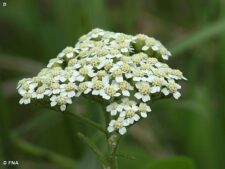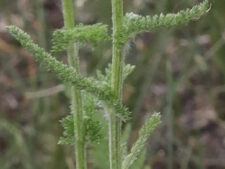
This native and/or introduced perennial has an erect 1-2 foot stem. The woolly appearance is due to fine hairs on the stem and leaves (C). Aromatic leaves up to 6 inches long are divided into many segments giving them a lacy, fern-like appearance (A,C). Many individual 1/2 inch flowers, consisting of 5 white (sometimes pinkish) petal-like ray florets and a yellow central disk, form a flat to convex branching cluster 2-4 inches in diameter (B).
Flowering occurs mostly from June through July, but sometimes into September on disturbed, dry sites in prairies, pastures and roadsides. It is uncommon in prairie restorations at Neale Woods. Marjorie Garabrandt’s inventory of plants at FF and NW indicates this plant was collected at FF in 1950, but there are no recent records.
Other common names including Milfoil, Nosebleed Weed, Old Man’s Pepper and Soldier’s Woundwort, provide clues to Yarrow’s past use as a medicinal agent for ailments including colds, fever, skin rashes, toothache, indigestion and bleeding. It was even touted as a preventative for baldness.
Plants of Eurasian origin introduced as a garden plant cannot be reliably separated in the field from our native North American populations.
The genus was named for the Greek warrior Achilles, said to have used the plant to heal wounds. Its many divided leaf segments prompted the species name millefolium, from the Latin word meaning ‘thousand leaves’.
The content of NatureSearch is provided by dedicated volunteer Naturalists of Fontenelle Forest who strive to provide the most accurate information available. Contributors of the images retain their copyrights. The point of contact for this page is: Neal Ratzlaff.

 Identification
Identification
